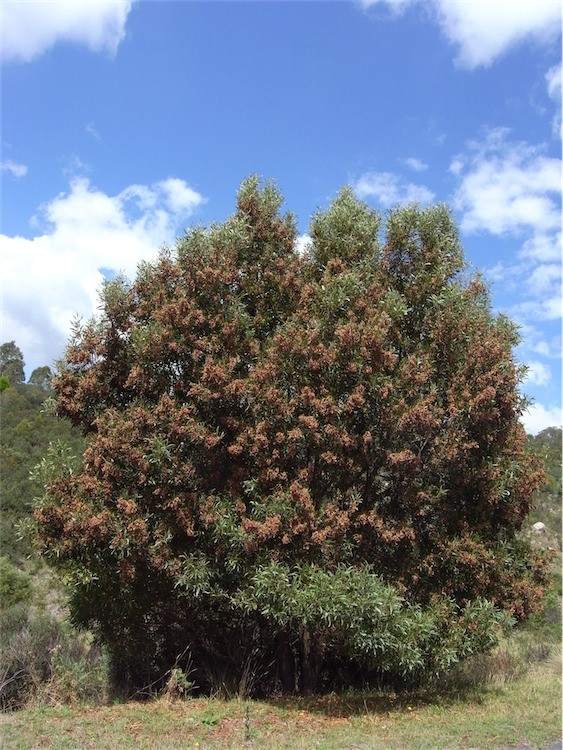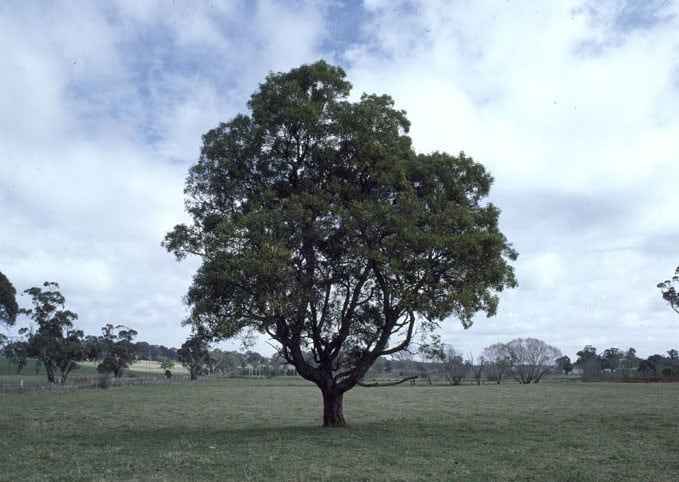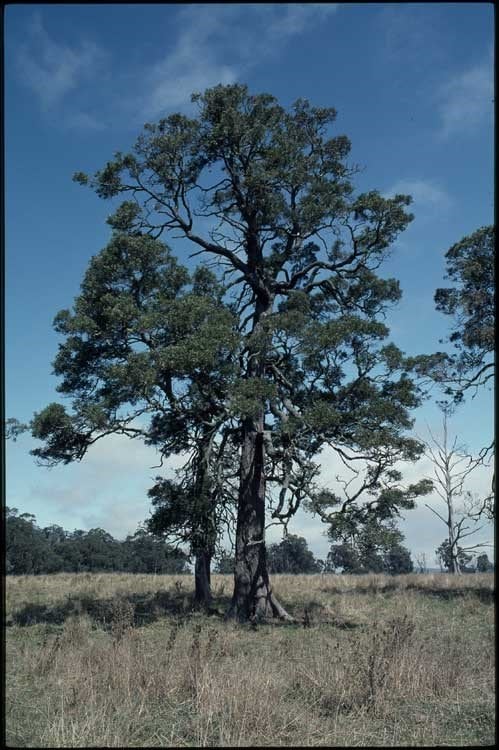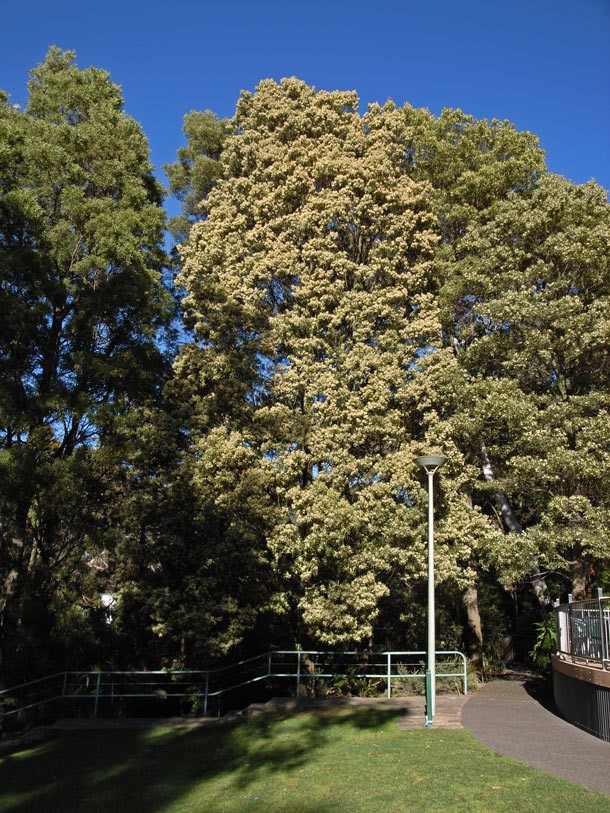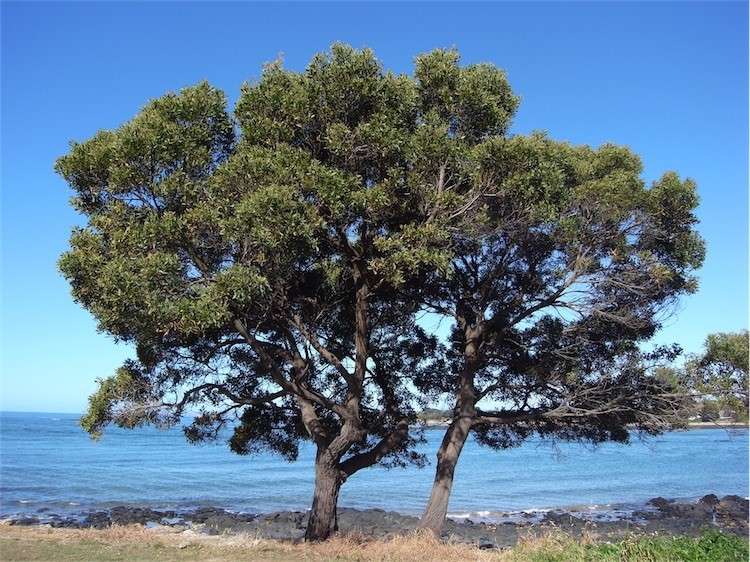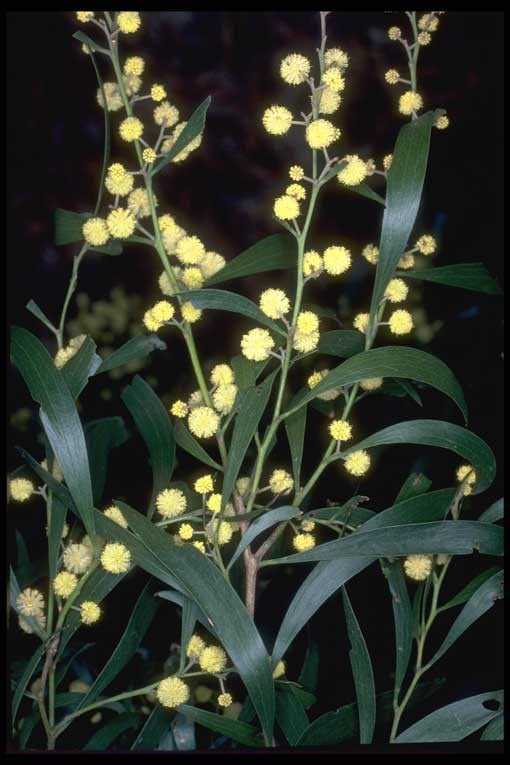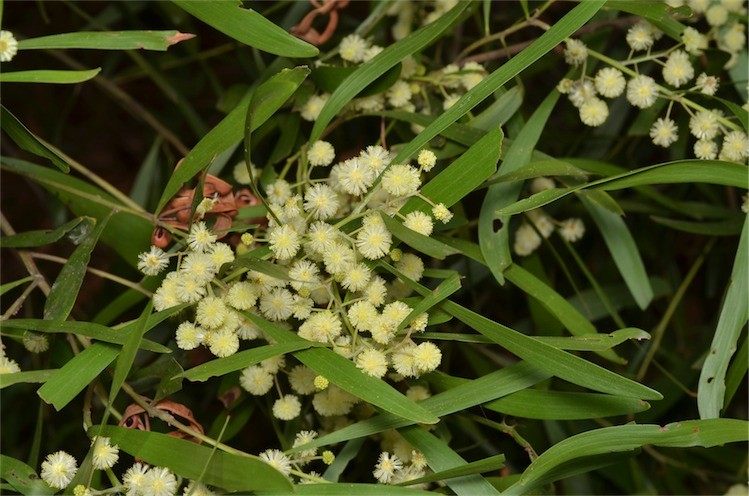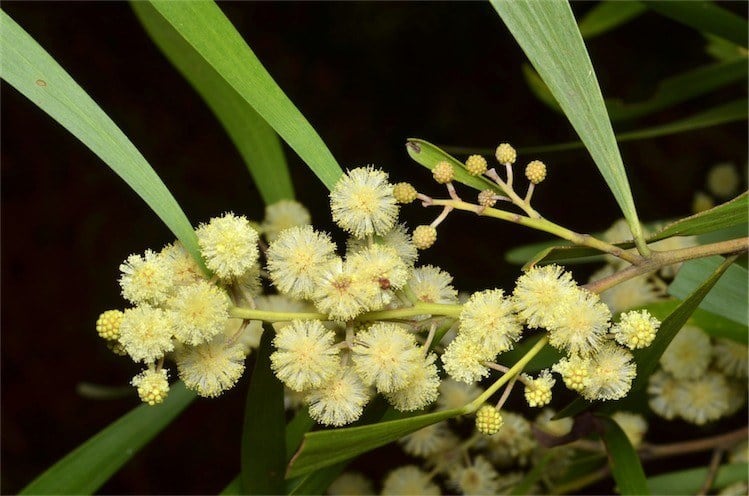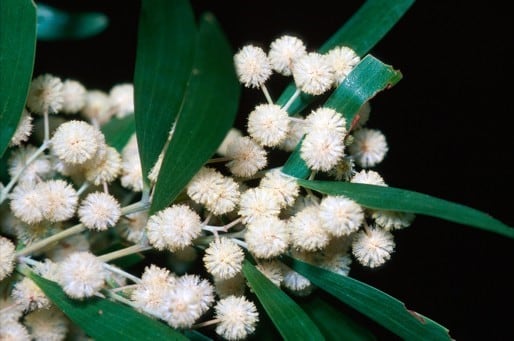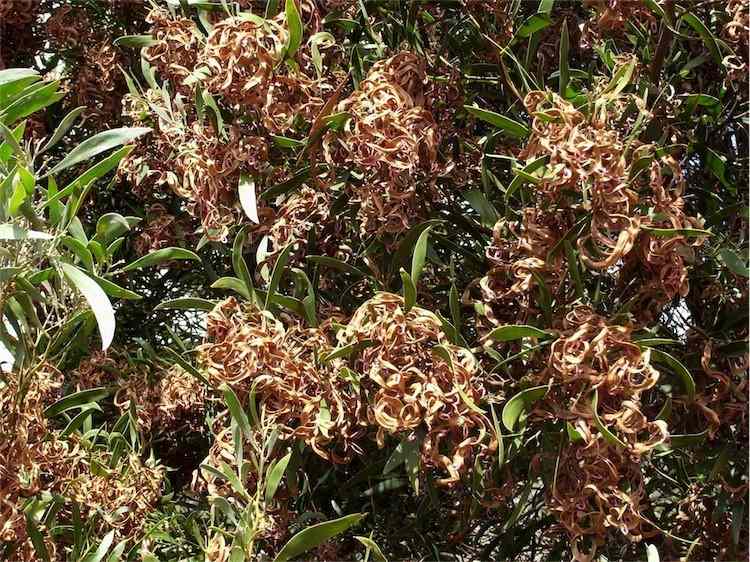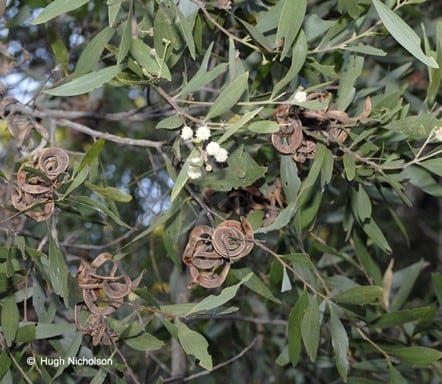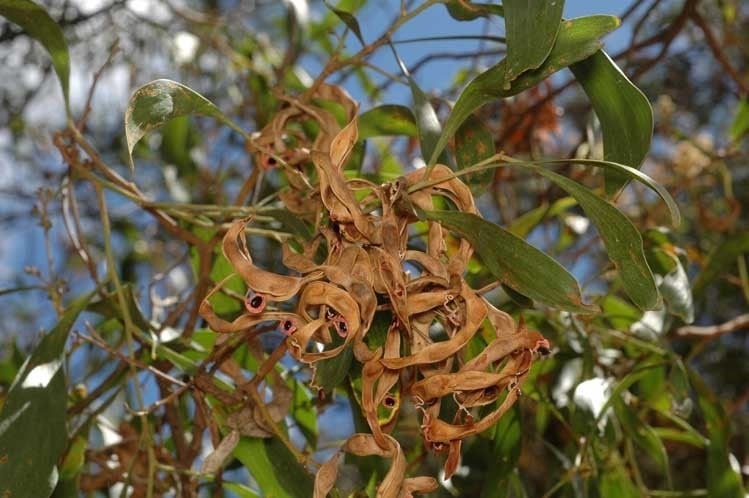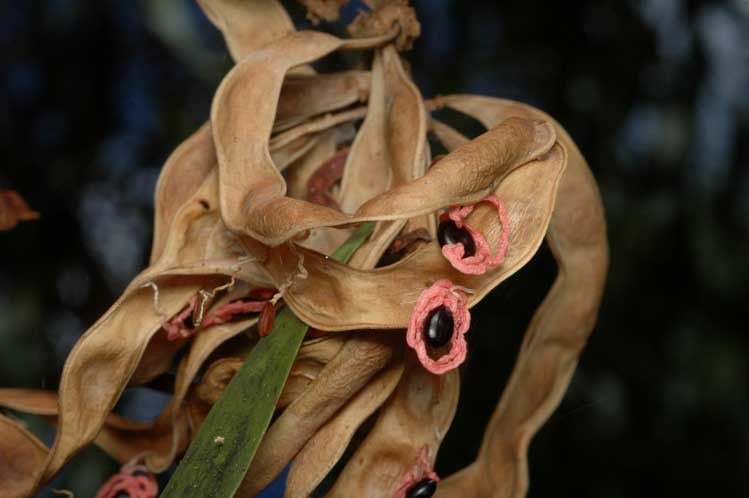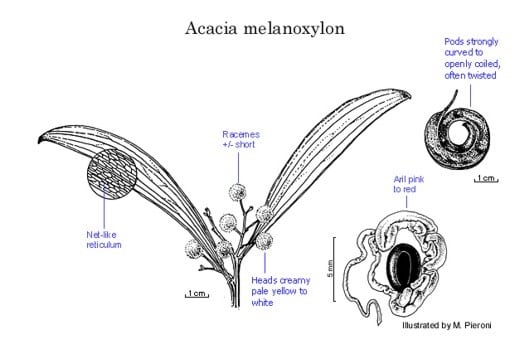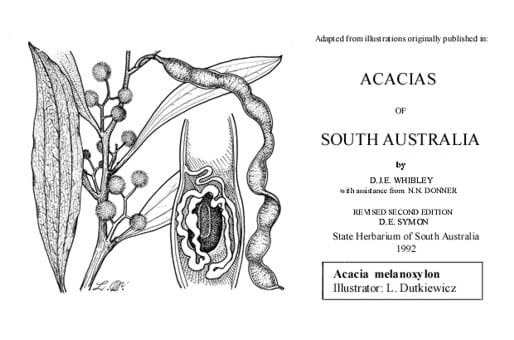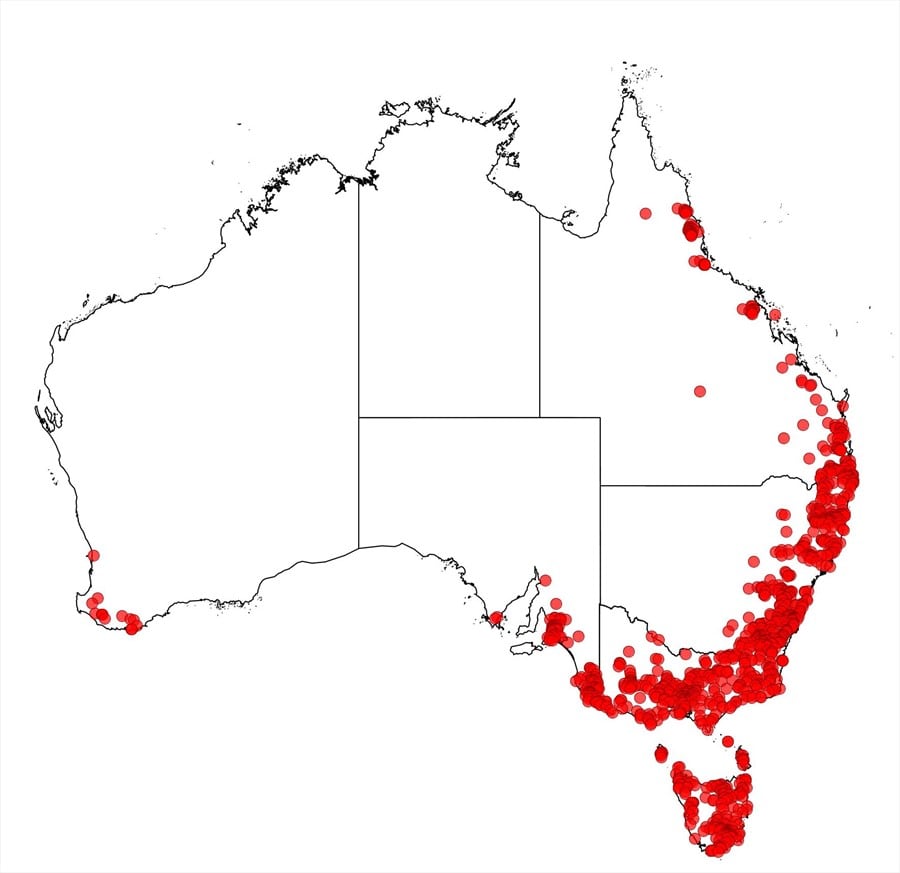Acacia melanoxylon R.Br.
WATTLE
Acacias of Australia
Common Name
Blackwood, Hickory, Sally Wattle, Mudgerabah
Family
Fabaceae
Distribution
Widespread, often common in south-eastern Australia, extending from the Atherton Tableland S through the highlands of Qld, N.S.W., A.C.T., Vic. and Tas., also the Mt Lofty and Flinders Ranges, S.A.; naturalized in places in south-western W.A.
Description
Tree 6–30 (–45) m high; sometimes a shrub 1.5–3 m high; may spread by root suckers; bipinnate leaves often persist on young plants. Bark hard, fissured and somewhat scaly. Branchlets angular at extremities, ribbed, glabrous, rarely puberulous. Phyllodes narrowly elliptic, lanceolate or oblanceolate, often inequilateral, straight to ±falcate, 4–16 cm long, 6–30 mm wide, obtuse to acute, ±coriaceous, dark green, glabrous, with 3–5 main nerves and prominently reticulate in between (nerve islands ±rectangular). Inflorescences comprising mostly 3–5-headed racemes; raceme axes 6–40 mm long; peduncles 4–13 mm long, glabrous or puberulous; heads globular, 6 mm diam., 30–56-flowered, creamy pale yellow to white. Flowers 5‑merous; sepals 3/4 or more united. Pods strongly curved to openly coiled and often twisted, to 15 cm long, 3.5–8 mm wide, coriaceous to subwoody, glabrous. Seeds longitudinal, broadly elliptic, 3–5 mm long, glossy, black; funicle fleshy, pink to deep red, twice-encircling seed.
Habitat
Grows in a diversity of habitats, but favours fertile soils in valleys and on flats in mountainous areas, often growing in wet sclerophyll forest and cooler rainforest. In north-western Tas. A. melanoxylon grows as a tall dominant tree in forested seasonal swamps.
Specimens
W.A.: Lake Powell Nat. Res., Elleker, G.J. & B.J.Keighery 190 (PERTH). S.A.: Mt Lofty summit, c. 12 km SE of Adelaide, 2 Sept. 1922, E.H.Ising s.n.(AD). Qld: near Crater Natl Park, A.K.Irvine 47 (BRI). N.S.W.: Chaelundi Mtn, 37 km N of Ebor, H.Streiman 8159 (PERTH); Camerons Camp, Ballangry State Forest, A.Gunnell 23 (PERTH). A.C.T.: 8 km SW of Uriarra HS on Uriarra/Brindabella road, J.M.Fox & K.J.Cowley 88/032 (CANB n.v., NSW). Vic.: The Lakes Natl Park, Rotamah Is., I.Crawford 498 (PERTH). Tas.: Warners Sugar Loaf, J.Playford 8916 (CANB).
Notes
Often confused with A. implexa which differs in its branchlets being commonly pruinose, phyllodes with the reticulum comprising more elongated nerve islands and by its funicle/aril which is white and not encircling the seed. Related to, and superficially very similar in habit and foliage to A. frigescens, with which it is sometimes sympatric. Also seemingly related to A. oraria which has broader pods and is scurfy on its branchlets, phyllodes and inflorescences, especially when they are young.
One of the most wide ranging tree species in eastern Australia and considerably variable, particularly in phyllode size and shape, where the variation appears to be continuous (see T.P.Farrell & D.H.Ashton, Austral. J. Bot. 26: 365, 1978, for discussion of variation in phyllode shape and size). There is considerable allozyme variation, both within and between populations, as demonstrated by J.Playford et al., Austral. J. Bot. 41: 355–368 (1993). This study showed that populations north of the Hunter R., N.S.W., differ substantially in terms of their chemistry from those to the south; the Ebor population (N.S.W., north of the Hunter R.) was atypical. Notes on ecology and timber value of A. melanoxylon in Tas. are provided by S.M.Jennings, Blackwood, Native Forest Silviculture Technical Bulletin No. 10 (1991).
Wood prized for cabinet work, panelling and for stringed instruments. Cultivated in some countries (e.g. Zimbabwe, Sri Lanka) for lumber, fuelwood and amenity plantings, but the timber quality is inferior to the Australian grown wood (fide S.J.Midgley & K.Vivekanandan, in J.W.Turnbull (ed.), Australian Acacias in Developing Countries 132-135 (1987)). In South Africa the species has become an environmental weed which is difficult to control because of its fast growth rate and its vigorous regrowth from root suckers and regeneration from seed, fide C.H.Stirton, Plant Invaders 52-55 (1978). In cultivation, A. melanoxylon needs to be managed properly to ensure that it does not become invasive. Further information on the biological and ecological features, and the utilisation potential, of this species is given in B.R.Maslin and M.W.McDonald, AcaciaSearch: Evaluation of Acacia as a woody crop option for southern Australia, RIRDC Publication No. 03/017, 128–135 (2004).
FOA Reference
Data derived from Flora of Australia Volumes 11A (2001), 11B (2001) and 12 (1998), products of ABRS, ©Commonwealth of Australia
Author
R.S.Cowan, B.R.Maslin
Minor edits by B.R.Maslin & J.Rogers
This identification key and fact sheets are available as a mobile application:
URL: https://apps.lucidcentral.org/wattle/
© Copyright 2018. All rights reserved.
